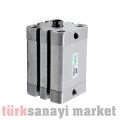Top rated
MAGNETIC PISTON
Full Magnetic Piston
The Full Magnetic Piston meets many technical requirements in the pneumatic industry with its bidirectional operation, dynamic sealing capacity, guiding feature and mechanical end buffering.
A NBR O-Ring acts as a static seal, ensuring the sealing of the piston rod, while an integrated magnetic positionMagnetic Sensors
Sick
Magnetic sensors, like inductive sensors, consist of three basic parts: LC oscillation circuit, signal evaluator and switching amplifier. They also contain a metal strip with high magnetic permeability.
This metal strip weakens the oscillation by using eddy current losses. Since a magnetic field will be applied when the magnet is brought closer to the sensor, this strip becomes magnetically saturated. The eddy current losses that weaken the oscillation circuit are reduced and the oscillation is strengthened again.
Unlike inductive sensors, the power consumption of magnetic sensors increases when the magnet is brought closer. As it is known, the oscillator current decreases when the metal is brought closer to the sensor in inductive sensors.
The situation is the opposite in magnetic sensors. For this reason, the detection distance is not as short as 2-20 mm as in inductive sensors, but can be up to 5 - 120 mm. The advantage of this technology is that it can be detected at long distances with small sensor sizes. Permanent magnets are used to trigger magnetic proximity sensors.
Magnetic Piston Sensors
The working principle of magnetic piston sensors is the same as magnetic sensors. The only difference is that these sensors are designed to work on a piston. Of course, the magnet, which is a part of the detection, must be present in the piston.
Magnetic cylinder sensors can be adapted to pistons made of aluminum, brass and stainless steel.
Piston speed / Sensitivity
Sensors can detect up to 5m/s piston speed without any problems.
The magnetic induction of pneumatic cylinder sensors is between 5 and 25 mTesla. A magnetic induction of 3 mTesla is sufficient to trigger the sensor.
MAGNETIC PISTON
Detection Distance
Detection distance is between 5 and 20 mm depending on the diameter, thickness and magnetic induction of the cylinder. The detection tolerance of this distance is 1 mm.
Magnetic Sensor Technology
Magnetic sensors are divided into two types as Reed and electronic according to their output types.
Electronic output sensors have long life, durability and fast switching ability. Reed output sensors have the advantage of working with universal supply.
MAGNETIC PISTON
However, they are disadvantageous in terms of durability, speed and service life. Therefore, the use of electronic output magnetic sensors should be preferred.
Electronic type sensors have transistor outputs such as npn or pnp. Reed type sensors, on the other hand, only provide output with a mechanical dry contact.
Magnetic Sensor Types According to Applications
SICK portfolio includes magnetic sensor types that can be used in both standard and difficult conditions.
MAGNETIC PISTON
For example, models suitable for use in welding environments or EX (Namur output) models designed for use in environments with explosion hazards.
The magnetic sensor has different types depending on the pneumatic cylinder model it will work on (T slot or C slot etc.). Adaptation can be made by using suitable mounting feet for different types of cylinders.
detects.
MAGNETIC PISTON Dimensions, magnetic flux and return spring channel can be completely customized according to the customer's needs.



